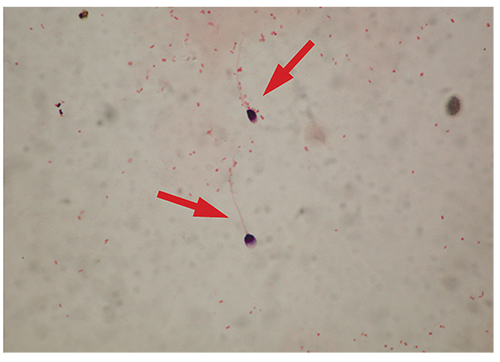Korean J Ophthalmol.
2013 Dec;27(6):459-462. 10.3341/kjo.2013.27.6.459.
Self-inflicted Chronic Bacterial Keratoconjunctivitis Using Self Semen
- Affiliations
-
- 1Department of Ophthalmology, Korea University College of Medicine, Seoul, Korea. crisim@korea.ac.kr
- 2Paju Public Health Center, Paju, Korea.
- KMID: 1792083
- DOI: http://doi.org/10.3341/kjo.2013.27.6.459
Abstract
- This case report describes a case of self-inflicted chronic bacterial keratoconjunctivitis involving the patient's own semen. A 20-year-old male soldier was referred to our clinic for the evaluation of refractory chronic bacterial conjunctivitis. Over the previous 4 months, he had been treated for copious mucous discharge, conjunctival injection, and superficial punctate keratitis in both eyes at an army hospital and a local eye clinic. Despite the use of topical and systemic antibiotics according to the results of conjunctival swab culture, there was no improvement. During the repeated smear and culture of conjunctival swabs, surprisingly, a few sperm were detected on Gram staining, revealing that the condition was self-inflicted bacterial keratoconjunctivitis involving the patient's own semen. Thus, in cases of chronic keratoconjunctivitis that do not respond to appropriate antibiotic treatment, self-inflicted disease or malingering should be considered.
MeSH Terms
-
Chronic Disease
Conjunctiva/*injuries/microbiology/pathology
Cornea/microbiology/*pathology
Diagnosis, Differential
Eye Infections, Bacterial/diagnosis/*etiology/microbiology
Eye Injuries/*complications/diagnosis
Humans
Keratoconjunctivitis/diagnosis/*etiology/microbiology
Male
Self Mutilation/*complications/diagnosis
*Semen
Young Adult
Figure
Reference
-
1. Patton N. Self-inflicted eye injuries: a review. Eye (Lond). 2004; 18:867–872.2. Sadock BJ, Sadock VA, Ruiz P, Kaplan HI. Kaplan & Sadock's comprehensive textbook of psychiatry. 9th ed. Philadelphia: Lippincott Williams & Wilkins;2009. p. 1949–1964. p. 2479–2490.3. Somerset EJ. Self inflicted conjunctivitis: an account of cases produced by the jequirity and castor oil seeds. Br J Ophthalmol. 1945; 29:196–204.4. Pokroy R, Marcovich A. Self-inflicted (factitious) conjunctivitis. Ophthalmology. 2003; 110:790–795.5. Noel LP, Clarke WN. Self-inflicted ocular injuries in children. Am J Ophthalmol. 1982; 94:630–633.6. Jones NP. Self-enucleation and psychosis. Br J Ophthalmol. 1990; 74:571–573.7. Winchel RM, Stanley M. Self-injurious behavior: a review of the behavior and biology of self-mutilation. Am J Psychiatry. 1991; 148:306–317.8. Waldfogel S, Field HL, Wu L. Oedipism in a patient with frontal lobe encephalomalacia. Brain Inj. 1994; 8:377–381.9. American Psychiatric Association. American Psychiatric Association Task Force on DSM-IV. Diagnostic and statistical manual of mental disorders: DSM-IV-TR. 4th ed. Washington, DC: American Psychiatric Association;2000. p. 513–517. p. 739–740.10. Lozzi O. Notes on some self-induced diseases in prison communities. Quad Criminol Clin. 1978; 20:87–98.11. Imrie FR, Church WH. Factitious keratoconjunctivitis (not another case of ocular Munchausen's syndrome). Eye (Lond). 2003; 17:256–258.12. Jay JL, Grant S, Murray SB. Keratoconjunctivitis artefacta. Br J Ophthalmol. 1982; 66:781–785.
- Full Text Links
- Actions
-
Cited
- CITED
-
- Close
- Share
- Similar articles
-
- Superior Limbic Keratoconjunctivits
- A Case of Epidemic Keratoconjunctivitis Complicated by Alcaligenes Xylosoxidans Infection
- Therapeutic Effect of Cyclosporine A Eyedrops in Vernal Keratoconjunctivitis
- Clinical Significance of Semen Analysis and Recanalization Rates after Vasectomy
- Gonococcal Keratoconjunctivitis in Adult




